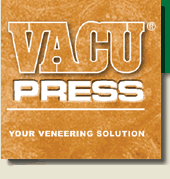Enrico Konig

Posts: 74
Joined: 2006-01-06
Location: Vancouver, BC
 User Profile User Profile |
Yes it is necessary to lower the pump pressure when gluing up the honeycomb panel, otherwise the honeycomb will be crushed. I use the Vacupress pump, and I dial it down to 10-12 hg for this first step. Never a problem with the bond. (And I have cut into a few of the first ones to check out the inside, when trying to figure out how to lessen deflection.) Then this sandwich needs to be flattened before the veneer is pressed at full pressure. I've flattened quite a few with just a handheld jointer planer and a straightedge until I discovered a widebelt sander at a nearby shop. The $100 is well worth it, especially when dealing with larger surfaces.
If you use Vacupress's honeycomb panels (and this is the only place in North America where I've found this dense-weave resin-impregnated stuff, at least where you didn't need to purchase a semi-trailer load), I believe it comes with full and clear instructions.
|






